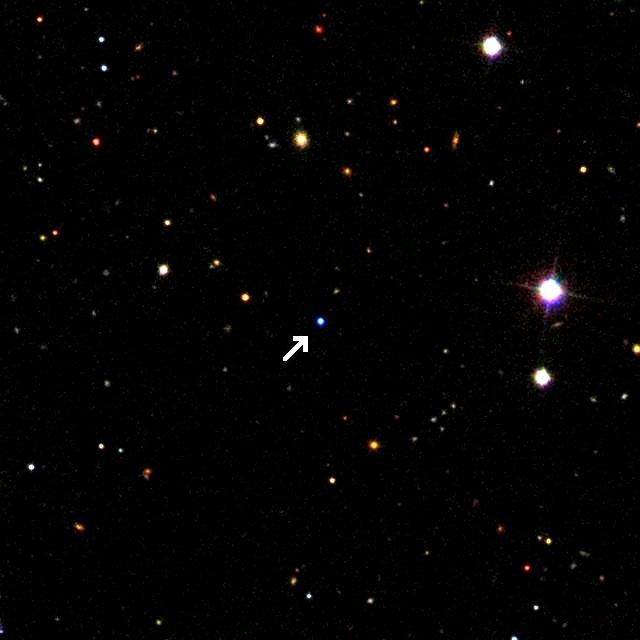
This photograph from the Sloan Digital Sky Survey shows the lowest mass white dwarf known in the galaxy (marked with an arrow). SDSS J091709.55+463821.8 is about 7,400 lights years away and orbits a close, but invisible, companion star. This image is about 4 arcminutes on a side, showing an area of the sky 1/40 the size of the Full Moon.
When a star like our Sun gets very old, after another seven billion years or so, it will no longer be able to burn its nuclear fuel. With only about half of the its mass remaining, it will shrink to a fraction of its radius and become a white dwarf star. White dwarfs are common, the most famous one being the companion to the brightest star in the sky, Sirius. But although they are common, and although they represent the final stage of our own Sun, astronomers still do not understand their full range of character, or the parameters that determine what they become. One reason is that many white dwarfs are, like the companion of Sirius, located in binary systems that are likely to influence the details of how they age.
SAO astronomer Warren Brown and three of his colleagues announced this week that they have discovered the lowest mass white dwarf known: a Saturn-sized ball of helium containing only about one-fifth the mass of the Sun. The new-found object lies about 7,400 light-years from Earth near the border of the constellations Lynx and Ursa Major. Although small in terms of mass, it is about nine times larger in dimensions than a typical white dwarf star.
Using SAO's MMT telescope at the Fred L. Whipple Observatory in Arizona, the astronomers conducted a survey of forty-two candidate low mass white dwarfs. From a meticulous analysis of their data, the team identified one candidate as being the lowest mass white dwarf known.
The scientists predicted the reason why this white dwarf has so little mass: it has an unseen companion (probably another white dwarf) that has sucked away much of its material. Finally, the team measured a telltale wobble in the movement of the white dwarf that demonstrated this prediction was correct. The results not only shed light on the geriatric community which our Sun will someday join, they also help to explain certain other astronomical phenomena, like pulsars; these objects also seem to have low mass white dwarfs as companions.